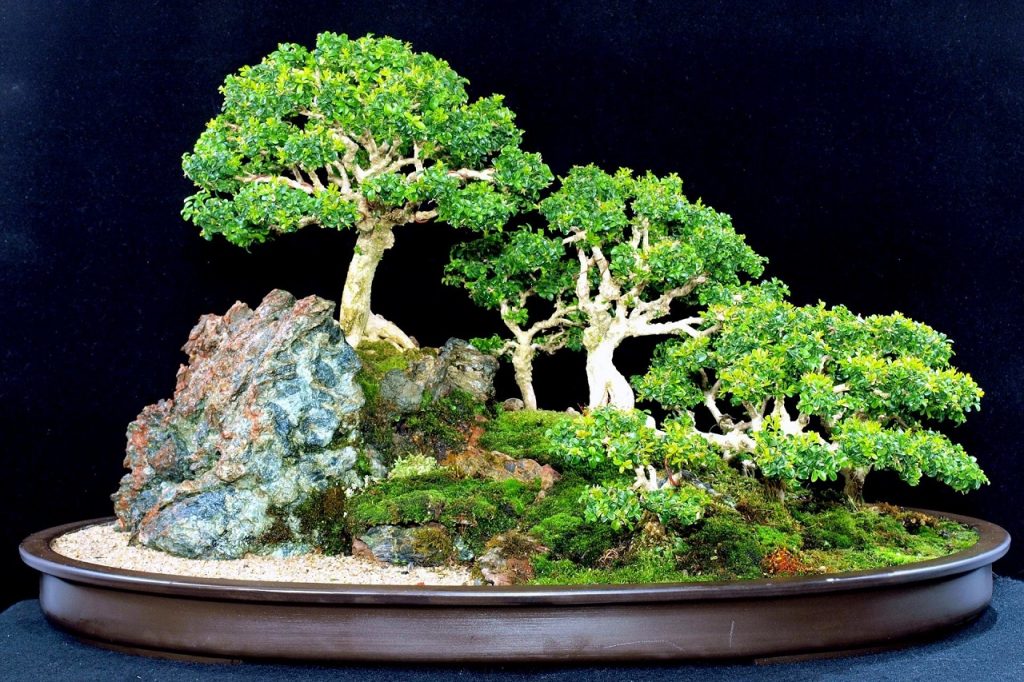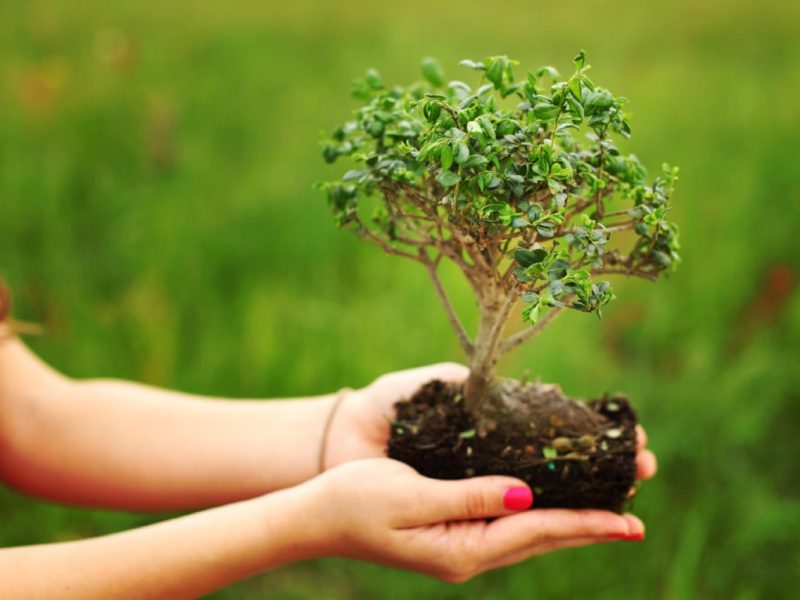In Japanese, bonsai means “plant in a flat vessel” (bon means container, sai means tree). The name comes from the Chinese character “pentsai” meaning “grown in a tray”.
Suiseki is the comprehension and enjoyment of nature in a stone, which is the shelter of the spirit Kami. In both Japanese and Chinese mythology and religion, forests, rocks, waterfalls, mountains, and valleys were considered the homes of Kami spirits. According to Shintoism, every object has a Kami spirit, and the components of that object are in turn endowed with Kami. Each grain of sand, each atom, has its own spiritual power. Hence, in the Japanese worldview there is a love of the miniature.
Philosophy of Bonsai
The word “bonsai” means not just a dwarf plant, but an entire philosophy, Taoism or Zen Buddhism, reflecting the idea of “the great in the small.” This philosophy, requires from a person certain personal qualities: wisdom, benevolence, delicacy, justice, patience. Masters of bonsai can recreate the image of a powerful thousand-year-old tree, form a landscape of dense forests, mountains and gorges, the seashore – and all this on a small piece of land.
The task is not only to grow a healthy plant in a container, but also to create a single harmonious whole of three elements – the plant, the soil and the pot, each of which should have a natural and attractive appearance.
- The soil should look like a natural part of the terrain, carefully selected stones (rocks) and moss (grass) – evoke associations with a natural forest landscape.
- The container is preferably chosen as laconic as possible, its color and shape should favorably set off the color and shape of the plant.
- The plant should have a resemblance to an established tree of the same species growing in natural conditions.
Origins of Bonsai
Long before bonsai became a hallmark of Japanese culture, an art called “Pengjing,” meaning “landscape in a pot,” originated in China. But the origins of this art go back thousands of years.
Sacred utensils and mountains of immortals
The first, most archaic layer refers to the tray “Peng”, whose shape repeats the ritual bowls of Yangshao and Matsyao cultures, which existed in the 5 – 3 thousand BC in the Yellow River Huanghe basin.
In these ancient Neolithic proto-Chinese cultures the first yin-yang symbols, swastikas and first Chinese drums appeared, i.e. the most archaic forms of Chinese mythology, based on the ancestor cult, were actively formed.
Already in the era of the first Chinese states of Shang (1600 -1046 b.c.) and Jou (1050-771 b.c.) these trays were used during palace rituals and ceremonies, presumably associated with the veneration of ancestors.
During the Han Dynasty (202 BC – 220 AD), the Chinese – ordinary people, scholars and priests – began to create miniature mountain landscapes on the Peng tray and decorated their homes and gardens with them. Sometimes they were used as incense burners – then they were called “boshanlu,” that is, “magical mountain roasters. These mountains were covered with moss and miniature figures of people and animals were placed next to them. We can find references to the use of such objects during the Jin dynasty as well. At that time, the stones were considered safe havens for spirits. Religious worship of stones is most closely linked to Taoism, a new religion formed in China on the basis of all the preceding ones.
Some boshanlu were created in the form of the Three Islands of Grace – Yinzhou, Fangzhan and Penglai – where immortal gods lived. The gods were believed to dwell in the mysterious, cloud-shrouded Western Mountains.
Sacred Tulasi Tree
Another tradition associated with the veneration of the sacred tree came to China from India and is associated with Buddhism at the turn of our era.
In ancient India, many plants and trees were used for medicinal purposes. Doctors and shamans grew medicinal plants in containers to make them easier to take with them when needed. In ancient manuscripts we find accounts of wandering Hindus practicing Ayurveda, a medical system that originated as early as the 3rd millennium B.C.
In India, from ancient times to the present, there has been a cult of worship of the sacred Tulasi plant, which is cultivated in a specially shaped pot. In many Hindu families, tulasi is grown in a specially built altar or on the veranda of the house. In the Puranas and other sacred scriptures of Hinduism it is said that tulasi is the embodiment of the goddess of prosperity and fertility, Lakshmi.
The art of “Panjing.”
Taoist monks, reinterpreting the Indian tradition began to grow the sacred tree of Buddhism on a sacred mountain from the Chinese tradition, so in the 1-2 centuries in the Han Empire, the art of “Pengjing” originated.
The earliest image of bonsai is in the tomb of Prince Zhang Huai, who died in 706 during the Tang Dynasty (618-907). Copies of the two wall paintings can be seen today in the Botanical Garden of Shanghai.
During the Southern Song Dynasty (960-1279), the art of growing trees in pots became extremely popular. Artists competed with each other, striving to create the most perfect tree and decorate it with the most beautiful stones. The interest in the art of bonsai was based on the belief that such trees imitate the natural environment and promote meditation.
Thus, bonsai symbolism originally contained three elements: a tray, a rock, a tree. The tray referred to the cult of ancestors, the mountain was associated with the idea of immortality and the divine presence, and the tree was associated with the idea of the tree of life and fertility.
Later, under the influence of Taoism bonsai began to take on the philosophical idea of the unity of the great and the small. In the 3rd and 4th centuries entire compositions began to appear, as the legend of the emperor, who commanded to create a miniature empire with all the trees, cities, rivers and mountains. Miniature trees were created for this purpose.
This tradition of decorating the composition with miniature figures and stones still survives in the Chinese version of Pengjing, which is the main difference between Pengjing and bonsai, where the onlooker is invited to consider the composition, which contains, besides the plant part, different landscape elements (stones), figures of people, animals, etc., while in bonsai the attention is almost entirely focused on the miniature plant.
Similarities of Pengjing
In order to get a better feel for the Japanese bonsai style, let’s see how the ancient Chinese tradition has caught on in other countries.
Vietnamese Honnonbo.
An offshoot of the Chinese pengjing is the Vietnamese Honnonbo art, which imitates islands, mountains and the surrounding nature. Like the Chinese version, it necessarily contains rocks, but is complemented by the presence of water. In Vietnamese, the name means “islands and mountains in a pot.”
A complete set of honnonbo which includes rocks, plants, small figures, a waterfall, and an aquarium.
Thai Mai Tai
Mai-Tai – angular and symbolic are Thai compositions that contain many jagged shapes, bright flowers and sometimes resemble stylized poses of dancers.
The emergence of bonsai in Japan
The first mention of bonsai in Japan dates back to the Kamakura period (1192-1333) in the records of the Shinto shrine of the Fujiwara Kasuga family, but the events depicted are from the Heian period (794-1191), indicating that bonsai appeared much earlier.
Probably as early as the 4th century the Chan sect monks brought the art of the tea ceremony and ikebana from China to Japan along with Buddhism, and with them the art of making miniature trees. The graceful tiny trees found a home in Buddhist monasteries. It is in the monastic environment that the art of growing “trees on trays” has its roots in Japan. As in China, it has become the privilege of the noble and wealthy. The samurai join the hobby. The path of the warrior, it turns out, is no stranger to communicating with the beautiful.
Records from the Kamakura period show that dwarf trees were sought in the fields and mountains and then turned into bonsai. The famous monk Noh, who created Hachi-no-ki (potted plants), worked with plants such as plum, cherry, and pine. This also confirms that Bonsai appeared before the 800s.
The first images of Bonsai appeared in the famous scrolls of the priest of that time, Honen (1133 – 1212). The images showed trees in their natural state, growing in bowls, standing on shelves.
Most of the adherents of this art in the world consider the Japanese style of bonsai as the benchmark. Japanese bonsai is notable for its refined naturalness and subtle harmony, its connection with the Japanese wabi-sabi aesthetics is clearly seen. In the XIII century, elegant plants in no less elegant vessels become an ornament in the gardens and homes of Japanese nobles, becoming not only the privilege of the rich, but also an important link in Japanese philosophy.
During the Edo period (1603-1868), imitating the aristocracy, the cultivation of dwarf trees became common among the townspeople. The favorite species of that time were pine, juniper, cryptomeria and plum. At this time, arts such as bonsai calligraphy and ekibana reached their heyday and were often represented in tea ceremony houses. In those years, it was mainly a garden plant and ornament; bonsai was brought into the house only for a short time. It was placed in a niche-tokonoma and had to harmonize with the room.
There was a relative lull for the art of bonsai in the late twentieth century, when Japan was actively recycling Western traditions.
In the Meiji era (1868 – 1912) a big event in the history of bonsai was the use of wire tying. Bonsai seedlings were selected from among old dwarf trees. Up until the 19th century they were sought in the mountains all over the country, when artificial cultivation – planting cuttings, grafting, division and grafting – began to develop. Chinese and Japanese pottery, antique and new, were considered most suitable for bonsai. Methods of admiring bonsai have also evolved.

How to admire bonsai
To appreciate a bonsai you should start looking at it from the bottom up, first evaluating the tree as a whole, then moving on to looking at its parts:
- First you should appreciate the spread of strong and beautiful roots
- Then the majestic appearance, reflecting the age of the tree
- Moving on to examining the shape of the branches, pay attention to their curved shape. The presence of straight, protruding branches in bonsai is considered a mistake.
- In conclusion you should evaluate the character of the work and try to comprehend the character of the master and the individuality of the work, because no two bonsai trees are alike as well as no two people are alike.
For admiring bonsai as a rule choose spring or autumn, but connoisseurs also like winter trees that have already lost their leaves. Also for admiring bonsai it is desirable to know what species it belongs to, to be able to distinguish different types of pines and junipers.
There are at least 12 styles of Bansai, differing in the shape of the tree. Connoisseurs can appreciate the beauty of bonsai by distinguishing the styles and knowing what mistakes to avoid.



